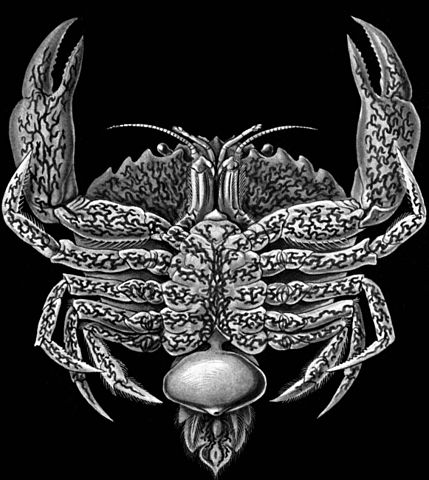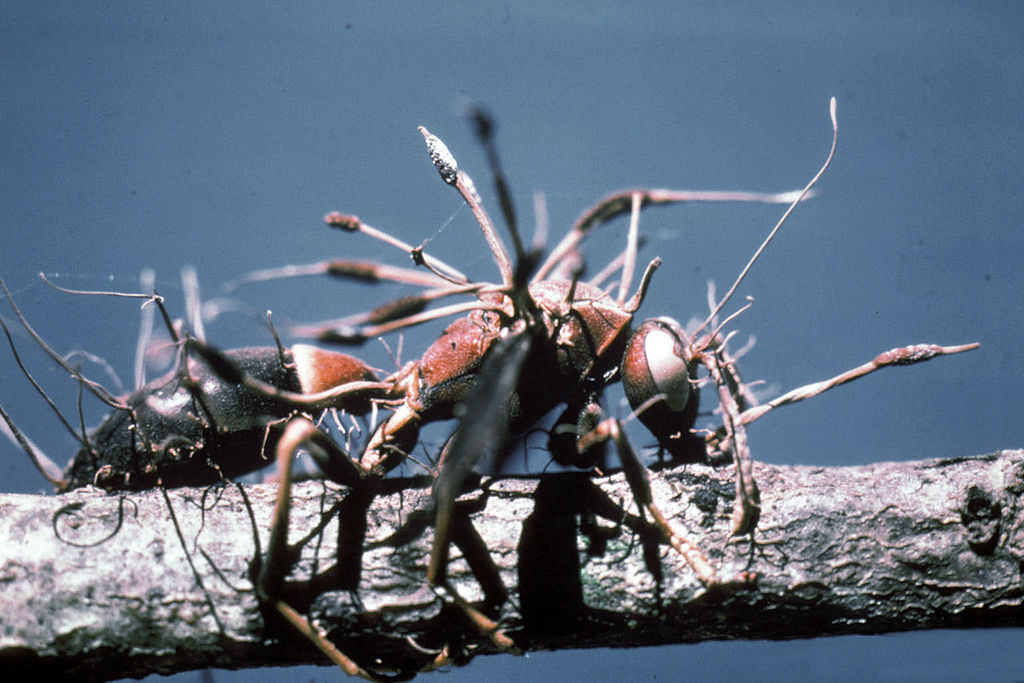Cover photo by Erich G. Vallery, USDA Forest Service – SRS-4552, Bugwood.org
Parasites are a beautiful nightmare.
The many lineages of parasites have evolved all sorts of twisted, macabre ways of making a living off their host. Some are content to live on our skin and feed off sweat and dead skin, while others must burrow deep inside to get their vittles. Some take up residence in our guts or veins and live off the easy food supply streaming by. The threat of invasion by a grotesque and alien being is darkly captivating, and has inspired books, museums, art exhibitions, and poetry, such as this little piece from 1733 by Jonathan Swift:
So, naturalists observe, a flea Hath smaller fleas that on him prey; And these have smaller still to bite 'em; And so proceed ad infinitum.
Our disgust at parasites is primal and deeply ingrained in our psyches. Parasites are an ancient threat that have been plaguing our ancestors from time immemorial. Sleep tight, don’t let the bed bugs bite. These little beasts have a way of worming into our minds.
Some parasites take that task to a more literal and horrifying level by invading the brains of their hosts to change their behavior. Beyond just being absolutely the most sinister nightmare fuel imaginable, this mind-controlling behavior makes good sense as an ecological strategy.
Crossing the Desert
Parasites face a fundamental dilemma. Inside their hosts, the world is moist, nutrient-rich, and relatively predictable. The challenges they face, like the host immune system, are the ones they are adapted to. Outside, however, the air is dry, the temperature swings wildly, and there are predators everywhere. The habitats where parasites can survive and thrive – their hosts – are separated by vast, inhospitable expanses. How to cross these deserts and make it to the next oasis?
Different lineages of parasites have evolved different solutions to this fundamental problem, although many of their strategies have a lot in common. Some parasites simply wait for their hosts to make direct contact, as is the case for sexually transmitted parasites. Many others have evolved very complex life cycles – their eggs, juveniles and adults are adapted to surviving in different conditions, like tadpoles and frogs. This allows them to live in environments that would otherwise be hostile while they make the journey to their final (“definitive”) target host.

It gets complicated
For example, Plasmodium, the genus of protists that cause Malaria, live the first stage of their life inside mosquitoes. The mosquitoes then conveniently inject the Plasmodium juveniles (sporozoites to be precise) directly into the bloodstream of their human hosts, where they can develop to maturity and reproduce. Their gametes (sperm and eggs) can then float in the human bloodstream until the next mosquito takes them up in a bite. Without this complex life cycle, Plasmodium would be unable to get from human to human, and would quickly die out. These complex strategies help parasites bridge the gap between hosts, increasing the odds of finding a new home for their offspring. Influencing host behavior is just another tactic that some parasites have evolved to solve the same problem. It does have a touch of abject horror to it, though, and one that the media has long capitalized on. TV is rife with images of the infected turning into zombies, losing their free will and being consigned to spreading their mind-altering sickness. The real thing is just as horrific.
Mind Control
There are many flavors of behavior altering parasites. Some cause their hosts to act aggressively, and spread through their bites. Others make their hosts seek out predators, or flail around in an obvious way, and then infect whatever unlucky hunter finds them first. Still more compel their hosts to climb up to a high spot with a good breeze or current and to spread the parasite’s spores or eggs.
Most species in the fungus genus Cordyceps make their living by growing inside and feeding off their insect hosts. These fungi are parasitoids, or parasites which eventually kill (or sterilize) their hosts. Some of these fungi manipulate the brains of their hosts, making them climb to a high tree branch and clamp their jaws down. This behavior creates the perfect spot for the fungi to fruit and send off their spores: the insect’s head is stationary and high enough off the ground that the spores might catch a breeze and travel farther. By getting inside the insect’s head (both literally and figuratively) the parasite is able to increase its chances of finding another host.
A very similar strategy can be seen in the parasitic barnacle genus Sacculina. This parasite slips through crevices in their crab host’s shells, then grows and reproduces inside them. They then change the crab’s behavior so that it treats the barnacle eggs as if they were its own; the crab climbs to high ground and releases the barnacle eggs into strong currents to ensure their wide dispersal. If the host crab is male, no problem – the barnacles “castrate” their host by destroying the gland producing male hormones and compelling the male to produce female hormones. Sacculina barnacles are as distantly related to Cordyceps as a human is to a portabello mushroom. Yet both parasites have converged on the same transmission strategy: force their hosts to seek high ground and spread the next generation of parasites far and wide.

A Carcinus crab being parasitized by Sacculina, illustration by Ernst Haeckel
Mind controlling parasites do not only live in faraway exotic rainforests and under the sea. Toxoplasma gondii is a protist that infects many mammals including humans – about a fifth of Americans are infected with this parasite, though most show no symptoms. Toxoplasma’s natural life cycle occurs in rodents and cats, and its mind-controlling effects reflect that. Toxoplasma changes the neural circuitry of its rodent hosts in a very specific manner, changing the rodent’s reaction to the smell of cat odors from fear to attraction. This increases the chance that the rodent will be eaten, thus passing on the Toxoplasma to the predator, and completing its life cycle.
Unfortunately for us, the neural circuits involved in fear response in rodents are evolutionarily shared with humans. For this reason, it seems Toxoplasma infecting human embryos can alter fear processing, and increase the likelihood of that child developing schizophrenia. This is why pregnant mothers are advised to not change cat litter – the Toxoplasma in cat feces can invade their baby’s brain. Check out the inimitable Robert Sapolsky expounding on parasitic brain control and Toxoplasma (with a slight misrecollection of the Sacculina system):
Beautiful Nightmares
The Toxoplasma system is relatively well understood; we still don’t know many of the specific mechanisms that parasites use to change the behavior of their hosts, and they are likely different for different parasites. But we do know that by destroying cells, secreting chemicals and generally running amok inside their hosts, these parasites can zombify their hosts to increase their own chances of getting passed along.
Parasites, as creepy as they are, are an important part of the ecosystems they live in, playing crucial roles in regulating host populations. They are highly coevolved with their hosts to get the nutrients they need, and transmit themselves or their offspring to the next host. Changing the behavior of hosts is just one of many impressive strategies parasites have evolved to provide the best possible future for their young. Taking a step back from the human impulse to be disgusted by all this, it really is remarkably complex and (dare I say it) morbidly beautiful.
References:
Libersat, Frederic, Antonia Delago, and Ram Gal. “Manipulation of host behavior by parasitic insects and insect parasites.” Annual review of entomology54 (2009): 189-207. DOI
Hughes, David P., et al. “Behavioral mechanisms and morphological symptoms of zombie ants dying from fungal infection.” BMC ecology 11.1 (2011): 13. DOI
Schaller, Mark. “Parasites, behavioral defenses, and the social psychological mechanisms through which cultures are evoked.” Psychological Inquiry 17.2 (2006): 96-137. DOI
Curtis, Valerie, Mícheál de Barra, and Robert Aunger. “Disgust as an adaptive system for disease avoidance behaviour.” Philosophical Transactions of the Royal Society B: Biological Sciences 366.1563 (2011): 389-401. DOI
Lafferty, Kevin D., and Jenny C. Shaw. “Comparing mechanisms of host manipulation across host and parasite taxa.” The Journal of experimental biology 216.1 (2013): 56-66. DOI
Mikheev, Victor N., et al. “Parasite-induced aggression and impaired contest ability in a fish host.” Parasit Vectors 3 (2010): 17. DOI
Dubey, J. P., and J. L. Jones. “Toxoplasma gondii infection in humans and animals in the United States.” International journal for parasitology 38.11 (2008): 1257-1278. DOI
Vyas, Ajai, et al. “Behavioral changes induced by Toxoplasma infection of rodents are highly specific to aversion of cat odors.” Proceedings of the National Academy of Sciences 104.15 (2007): 6442-6447. DOI
Yolken, R. H., F. B. Dickerson, and E. Fuller Torrey. “Toxoplasma and schizophrenia.” Parasite immunology 31.11 (2009): 706-715. DOI
Choisy, Marc, et al. “Evolution of trophic transmission in parasites: why add intermediate hosts?.” The American Naturalist 162.2 (2003): 172-181. DOI
Anderson, Roy M., and Robert M. May. “Regulation and stability of host-parasite population interactions: I. Regulatory processes.” The Journal of Animal Ecology(1978): 219-247. DOI
Swift, Jonathan. “On Poetry, a Rhapsody.” (1733) link

